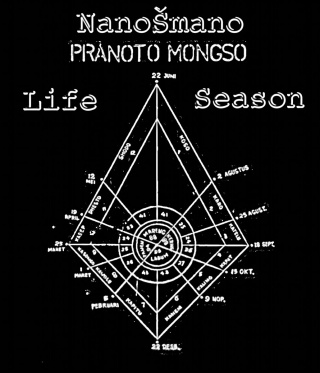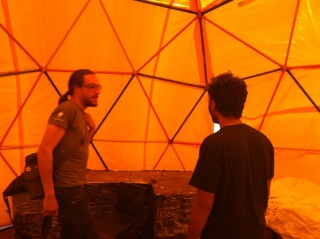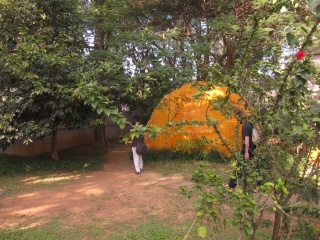Difference between revisions of "NanoŠmano - LifeSystem"
(→NanoŠmano - LifeSystems - LifeForms (June - August/September 2012), Ljubljana, Slovenia –) |
(→NanoŠmano - LifeSeason - LifeSystems - LifeForms (June - August/September 2012), Ljubljana, Slovenia –) |
||
| Line 5: | Line 5: | ||
coming soon... | coming soon... | ||
| − | [[File: | + | [[File:Flyer_NS3.jpg|320px]] |
Where | Where | ||
Revision as of 06:01, 9 January 2012
Contents
NanoŠmano - LifeSeason - LifeSystems - LifeForms (June - August/September 2012), Ljubljana, Slovenia –
When
coming soon...
Where
Who
Ideas
Work with DNA
BioDome
from Yashas:
http://www.byexample.com/projects/current/dome_construction
http://2011.igem.org/Team:ArtScienceBangalore/Outreach
NanoŠmano Life Number Generator
Insprired by some discussions with Mukund and Rohit (who loves prime numbers and other math wizardry), we could build upon our laser micro-projectors, see hackteria page. By using small micro-ecosystems, containing a small number of defined species and looking at the population dynamics using holographic imaging, as described below:
http://www.ncbi.nlm.nih.gov/pmc/articles/PMC2966488/?tool=pubmed
Depending on different ecologies inside we might get interesting and funny numbers out. Here are some ideas:
- Fibonacci numbers
- prime numbers
- zeros of the Riemann zeta function
- random Leskovsek numbers to feed a synth/pd
Participants
Stefan Doepner (DE/SLO) - http://www.f18institut.org/
Stefan Doepner studied Painting and Experimental Film at the University of Arts Bremen. Doepner's focus is on the artistic exploration of today's use, reception and rules of technology, to analyze and understand contemporary systems and techniques he acquires the method of reinvention. In his work Doepner tries to profane the technological glorification and to grasp the relations of society, technology, sound, science and every day life through meditation and mediation. 1992 Doepner participated at the Documenta9 project Van Gogh TV; 1993 co-founded MAB, Bremen; 1996 co-founded f18institut, Hamburg; since 1997 on going collaborations with Stelarc; 2006 co-founded Obrat and 2007 co-founded Cirkulacija2 in Ljubljana
Dr. Marc Dusseiller (CH) - http://www.dusseiller.ch/labs/
Marc R. Dusseiller is a transdisciplinary scholar, lecturer for micro- and nanotechnology, cultural facilitator and artist. He works in an integral way to combine science, art and education. He performs DIY-workshops in lo-fi electronics, music and robotics, has made various short movies and is currently developing means to perform biological science (Hackteria | Open Source Biological Art) in a DIY fashion in your kitchen or your atelier. He is also co-organizing Dock18, Room for Mediacultures, and various other engagments like the diy* festival, national and international workshops for both artists and schools and children as the president of the Swiss Mechatronic Art Society, SGMK. http://hackteria.org http://www.mechatronicart.ch
- extra funds should by applyed from Pro Helvetia.
- already in the application to KulturRaum Schaffhausen, 1-2k€ can be transferred to NS3
- will include in next hackteria application to Migros Kulturprozent and maybe others
Bostjan Leškovsek (SLO) - http://www.3via.org/IntermediateSpaces/
i guess you got some info about him.... Open Workshop As an open and collaborative workshop, we are looking forward to spontanous visits and participation of whoever will join us throughout the course of the workshop.
Invited Collaborators
some agronome or biologist?
Bengt Sjölén (SE)
Bengt Sjölén is an independent software and hardware designer/hacker/artist based in Stockholm with roots in the home computer demo scene. He is not part of one single group but rather collaborates with several networks. He mainly works in the areas of media art, science, sound, visuals, architecture and technology. http://automata.se * again contacted, Bengt is very interested in participating for another series of NS.
Prof. Dr. Erik Reimhult, NanoBiotechnology, BOKU, Vienna (SE/AT)
Erik Reimhult is a nanoscientist who works in the fields of Biointerfaces, Biosensors and Nanoparticle self-assembly. He is the author of numerous scientific publications and has also writen popular science article for various media. After several years of research at Chalmers University of Technology, A*Star Singapore and ETH Zürich, he is now full professor in the department of NanoBiotechnology at the University of Natural Resources and Life Sciences, Vienna. http://www.nano.boku.ac.at/ * we'll see if he can make it again
Potential Parttime Collaborators
Eva Ogorevc (SI)
more more
Old Stuff
Auszug von Antrag zu KulturRaum Schaffhausen, March 2011 -> Granted
Im September 2010 wurden ich eingeladen von der Kapelica Gallery in Ljubljana, gemeinsam mit einem Bildhauer, Stefan Doepner, und einem Soundkünstler, Bostjan Leškovsek, ein Projekt durchzuführen zum Thema Nanotechnologie. Im Rahmen unseres Ansatzes des Hackteria Projektes haben wir für zwei Wochen in der Gallerie ein öffentliches Labor installiert und zusammen mit Besuchern uns in einer kreativen, kritischen und spielerischen Art dem Thema angenähert. Unter dem Projekttitel „NanoŠmano, NanoPunk and the hacking of Future“ haben wir uns in dieser ersten Edition vorallem dem Thema der Tools, Analyse- und Manipulationssysteme auf Nanoskala gewidmet und schlussendlich eine Publikation, öffentliche Diskussionsrunden und Radioshows produziert und mehrere Prototyp-Artefakte erstellt. Der Erfolg dieses ersten Annäherungsversuches zur NanoKunst werden wir nun weiterführen und planen noch zwei zusätzliche Veranstaltung in ähnlichem Sinne. „NanoŠmano - Šmall Matter“ wird im April 2011 erneut in der Kapelica Gallery stattfinden und ist finanziell und organisatorisch schon abgesichert. Nach diesem zweiten Ansatz, bei welchem wir uns mit Materialien und speziellen Eigenschaften im Nanometerbereich widmen werden, planen wir eine dritte Veranstaltung als Abschluss dieser Serie im Frühjahr 2012, „NanoŠmano – The Convergence“. In dieser letzten Phase werden wir uns künstlerisch dem Verschmelzen der Disziplinen von Biologie, Physik und Informatik widmen, welche das Gebiet der Nanotechnologie auszeichnet. Durch diesen transdisziplinären Ansatz und Zusammenarbeit von Künstlern, Programmierern, Musikern und Wissenschaftlern wollen wir einen kritischen Dialog fördern sich mit den gesellschaftlichen Utopien, Risiken und realistischen Aspekten der Nanotechnologie auseinanderzusetzen. Für diese von mir geleiteten NanoLaboratorien, werde ich in Zusammenarbeit mit Jurij Krpan, Kurator Kapelica, und Stefan Doepner für 4 Wochen in Ljubljana als Artist in Residence arbeiten, für Vorbereitung, Durchführung und Post-Produktion. Finanziell wird das Projekt getragen durch das Slowenische Ministerium für Kultur, die Stadt Ljubljana, Pro Helvetia (Antrag geplant) und hoffentlich auch KulturRaum Schaffhausen.
Texts from NanoŠmano - Šmall Matter
Overview
In the second edition of NanoŠmano, we are starting new explorations into the world of matter on the nanoscale by investigating its physical and aesthetic potentials. As an open research based and collaborative workshop with participating artists, hackers and scientists, we want to elicit methods to enable the creative uses and playful integration of nanomaterials into the artistic process. We will also develop simple NanoŠmano artefacts to stimulate an experiancable audio/visual atmosphere of Šmall Matter and hopefully develop concepts for future introductory experimentations to document, publish and share.
Date: around eastern end of April, depending on Marc's university schedule in Basel.
Duration/Timeplan: 10 Days The workshop will combine the collaborative research, experimentation and production phase with various public events, such as an opening when the lab is set up, a round table discussion and a final exhibition.
Background
With the current scientific endeavor to produce, explore and manipulate materials on the nanometer scale the recent years have led to a convergence of disciplines from physics, engineering and biology. These disciplinary boundaries have been unfruitful to further the understanding of the world on the small scale and also the boundaries of synthetic or living, artifical or inorganic diffuse into one. A "synthetic nanoparticle" is in fact a combined system of inorganic matter, such as titaniumoxide, with a thin layer of organic macromolecules on its surface, and even comined with biological molecules, such as proteins or DNA-fragments, to control its interaction within a living system. And inside a single living cell, we can find a multitude of complex structures and machinery of proteins and inorganic particles. Examples like magentotactic bacteria show how life forms have long time ago come up with nanobio-systems to enable them to sense magnetic fields, or vice-versa the engineered biosynthesis of new nanomaterials using biological entities, such as the formation of CdSe-quantum dots in fungus (Fusarium Oxysporum).
Approach and Aims
With this in mind, we now want to expand this disciplinary convergence by working as a team of sculptors, scientists, sound artists, programmers and hackers.
Documentation and Disseminatio n
Besides the local public events and print material using the network and resources of Kapelica Gallery, we will publish the progress of the workshop online on the hackteria webplatform, write and share instructions on the developed projects and publish a new edition of the NanoŠmano Fanzine.
Location: Allthough the Kapelica Gallery was a great venue for the first edition of NanoŠmano, we are now planning to hold the workshop in another venue in the city center of Ljubljana. A larger visibility of the process and the interaction with people from the streets seem to us another important dimension to include into our research.
Participants
Stefan Doepner (DE/SLO) - http://www.f18institut.org/ studied Painting and Experimental Film at the University of Arts Bremen. Doepner's focus is on the artistic exploration of today's use, reception and rules of technology, to analyze and understand contemporary systems and techniques he acquires the method of reinvention. In his work Doepner tries to profane the technological glorification and to grasp the relations of society, technology, sound, science and every day life through meditation and mediation. 1992 Doepner participated at the Documenta9 project Van Gogh TV; 1993 co-founded MAB, Bremen; 1996 co-founded f18institut, Hamburg; since 1997 on going collaborations with Stelarc; 2006 co-founded Obrat and 2007 co-founded Cirkulacija2 in Ljubljana
Dr. Marc Dusseiller (CH) - http://www.dusseiller.ch/labs/ Marc R. Dusseiller is a transdisciplinary scholar, lecturer for micro- and nanotechnology, cultural facilitator and artist. He works in an integral way to combine science, art and education. He performs DIY-workshops in lo-fi electronics, music and robotics, has made various short movies and is currently developing means to perform biological science (Hackteria | Open Source Biological Art) in a DIY fashion in your kitchen or your atelier. He is also co-organizing Dock18, Room for Mediacultures, and various other engagments like the diy* festival, national and international workshops for both artists and schools and children as the president of the Swiss Mechatronic Art Society, SGMK.
http://hackteria.org http://www.mechatronicart.ch
* extra funds should by applyed from Pro Helvetia, they generally can only cover travel and accomodation (no material/production cost) in the range of 10 to 20% of total budget of the project. latest 8 weeks (better 3 months, meaning january!) in advance to be applied by the foreign institution via online portal. Visual arts will be the most promising discipline to apply to:
http://www.prohelvetia.ch/Visual-Arts.118.0.html?&L=4
maybe around 1000 to 2000 € should be possible, otherwise potential funds from the hackteria project could be invested (if granted at all, gonna now by january)
Bostjan Leškovsek (SLO) - http://www.3via.org/IntermediateSpaces/
i guess you got some info about him....
Open Workshop
As an open and collaborative workshop, we are looking forward to spontanous visits and participation of whoever will join us throughout the course of the workshop.
Potential Collaborators:
Prof. Dr. Erik Reimhult, NanoBiotechnology, BOKU, Vienna (SE/AT)
Erik Reimhult is a nanoscientist who works in the fields of Biointerfaces, Biosensors and Nanoparticle self-assembly. He is the author of numerous scientific publications and has also writen popular science article for various media. After several years of research at Chalmers University of Technology, A*Star Singapore and ETH Zürich, he is now full professor in the department of NanoBiotechnology at the University of Natural Resources and Life Sciences, Vienna.
http://www.nano.boku.ac.at/
* already contacted, and we are planning a visit for a couple of days. funding not yet discussed.
Bengt Sjölén (SE)
Bengt Sjölén is an independent software and hardware designer/hacker/artist based in Stockholm with roots in the home computer demo scene. He is not part of one single group but rather collaborates with several networks. He mainly works in the areas of media art, science, sound, visuals, architecture and technology.
http://automata.se
* also contacted, Bengt is very interested in participating. Funding not discussed, potential governmental funding partner in Sweden should be contacted. maybe in combination with Erik, cos they are both Swedes...


